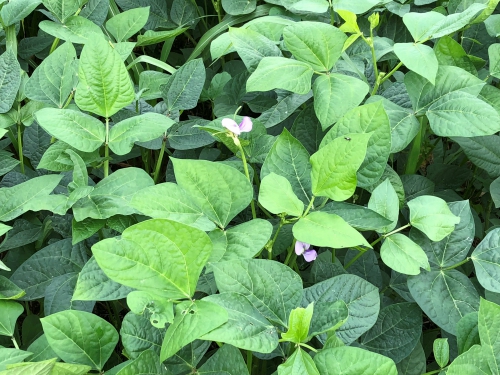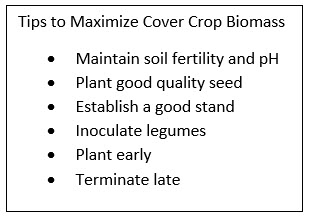When Should I Terminate My Cover Crop?

There are many things to consider when deciding when to terminate your cover crop. The first consideration is when you expect to plant your cash crop. The second consideration is how wet the soil is and whether you can plant the field without creating a mess. These two considerations can influence cover crop termination timing more than any other considerations, but maximizing cover crop biomass is also important.
Cash crop planting time. Determine when you want to plant your cash crop and then add at least three weeks. Most vegetable producers mow and incorporate their cover crops, then form a seed bed for their cash crop. The cover crop residue needs to decompose before planting. If soil conditions are moist and warm, decomposition happens in about three weeks. If the soil is cool, add extra time. If conditions are dry, you may need to irrigate to allow the residue to decompose. Small seeded crops such as carrots may need a longer time after incorporation before planting.
If you are transplanting vegetables into cover crop residue on the surface (no-till), you should also leave a three to four-week window between termination and planting to reduce the risk of cut worms and other insect pests, seedling-borne diseases, nutrient immobilization, and allelopathy from the cover crops. Organic producers need to pay careful attention to when the cover crop is in reproductive stage to ensure the cover crop can be killed before planting. In general, small grain cover crops should be past flowering and in the milk to dough stage (This is when the grain seed begins to form. Milk is when the grain seed squirts out a milky fluid when pressed with the fingernail. Dough is when the seed has a doughy feel). Legumes should be at 2/3 bloom before termination.
Soil moisture. Remember working wet soil destroys soil structure that takes years to rebuild. If you can squeeze a handful of soil and make a ball that is wet or does not break apart when it is dropped on the ground, the soil is too wet to work. Mowing and incorporating cover crop into wet soil can create conditions that make a good seed bed very difficult to prepare.
 Cover crop biomass. In general, you obtain the most benefit from the cover crop with maximum biomass. However, these benefits need to be balanced with potential difficulties from planting into large amounts of residue. Large amounts of cover crop residue may be difficult for producers that do not have large equipment to properly incorporate it. If you do not have the experience or equipment to be able to plant your cash crop, you may want to start with cover crop species, like wheat, millet or buckwheat, that produce lower amounts of cover crop residue. You should recognize the lower amounts of residue may decrease the desired benefits provided by the cover crop, such as weed control.
Cover crop biomass. In general, you obtain the most benefit from the cover crop with maximum biomass. However, these benefits need to be balanced with potential difficulties from planting into large amounts of residue. Large amounts of cover crop residue may be difficult for producers that do not have large equipment to properly incorporate it. If you do not have the experience or equipment to be able to plant your cash crop, you may want to start with cover crop species, like wheat, millet or buckwheat, that produce lower amounts of cover crop residue. You should recognize the lower amounts of residue may decrease the desired benefits provided by the cover crop, such as weed control.
The maximum cover crop biomass typically occurs when the cover crop is entering its reproductive stage. In late March to May, biomass of winter cover crops, like cereal rye and crimson clover, can double in two to four weeks. Summer cover crops like sorghum sudangrass or sunn hemp can produce large amounts of biomass (>6,000 lbs/acre) in as little as three months.
Maximizing biomass is also important for maximizing nitrogen. Legumes tend to fix nitrogen most rapidly just before bloom, and because the amount of available nitrogen provided by a legume cover crop is a product of the amount of biomass and the nitrogen concentration, maximizing biomass also will maximize the potential nitrogen that may be available. Remember legume cover crops need to be used carefully in your crop rotation to reduce the risk of building up disease or pest pressure. Never use a legume cover crop before a legume cash crop, such as beans.
Although there are advantages to maximizing biomass, this can be difficult for vegetable producers that grow cash crops nearly year-round. It is important to look for windows of opportunity for cover crops in your rotation, and plant cover crops that can perform well in the windows you identify.
More Information:
- Organic Cool-Season Vegetable Crop Rotations for the Southeast – contains information on summer cover crops and termination.
Contributors:
Julia Gaskin, Extension Specialist-retired, University of Georgia; Dr. Annette Wszelaki, Professor University of Tennessee-Knoxville
